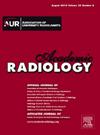基于生成对抗网络的对比度增强:合成对比度脑磁共振成像。
IF 3.8
2区 医学
Q1 RADIOLOGY, NUCLEAR MEDICINE & MEDICAL IMAGING
引用次数: 0
摘要
原理和目的:磁共振成像(MRI)是诊断神经系统疾病的重要工具,经常使用钆基造影剂(gbca)来提高分辨率和特异性。然而,gbca存在一定的风险,包括副作用、成本增加和反复暴露。本研究提出了一种利用生成对抗网络(GANs)进行脑MRI虚拟对比增强的创新方法,旨在减少或消除gbca,将相关风险降至最低,并在保持诊断质量的同时提高成像效率。材料和方法:在本研究中,在3.0特斯拉MRI扫描仪上获得了81名参与者(54名女性,27名男性;平均年龄35岁,年龄范围19-68岁。给予标准剂量的GBCA后获得t1加权和对比增强图像。为了生成对比度增强t1加权的“合成”图像,训练了GAN结构的子模型CycleGAN模型来处理对比度前和对比度后的图像。数据集分为三个子集:80%用于训练,10%用于验证,10%用于测试。在整个训练阶段使用TensorBoard来防止图像劣化,并优化图像处理和训练程序。放射科医生被提供了一个无对比度的输入图像,并被要求在真实的对比度增强图像和由CycleGAN生成的与该无对比度的MR图像相对应的合成MR图像之间进行选择(图灵测试)。结果:采用定量分析和定性分析相结合的方法评估CycleGAN模型的性能。对于整个数据集,在测试集中,均方误差(MSE)为0.0038,结构相似指数(SSIM)为0.58。子模型中,最成功的模型MSE为0.0053,SSIM为0.8。通过四名具有不同临床经验水平的放射科医生进行的视觉图灵测试,定性评估得到了验证。结论:本研究结果支持CycleGAN模型生成合成对比增强t1加权脑MR图像的有效性。定量和定性评价均表现出优异的性能,证实了该模型产生逼真合成图像的能力。这种方法有望潜在地消除静脉造影剂的需要,从而将其使用的相关风险降至最低。本文章由计算机程序翻译,如有差异,请以英文原文为准。
Generative Adversarial Network Based Contrast Enhancement: Synthetic Contrast Brain Magnetic Resonance Imaging
Rationale and Objectives
Magnetic resonance imaging (MRI) is a vital tool for diagnosing neurological disorders, frequently utilising gadolinium-based contrast agents (GBCAs) to enhance resolution and specificity. However, GBCAs present certain risks, including side effects, increased costs, and repeated exposure. This study proposes an innovative approach using generative adversarial networks (GANs) for virtual contrast enhancement in brain MRI, with the aim of reducing or eliminating GBCAs, minimising associated risks, and enhancing imaging efficiency while preserving diagnostic quality.
Material and Methods
In this study, 10,235 images were acquired in a 3.0 Tesla MRI scanner from 81 participants (54 females, 27 males; mean age 35 years, range 19–68 years). T1-weighted and contrast-enhanced images were obtained following the administration of a standard dose of a GBCA. In order to generate "synthetic" images for contrast-enhanced T1-weighted, a CycleGAN model, a sub-model of the GAN structure, was trained to process pre- and post-contrast images. The dataset was divided into three subsets: 80% for training, 10% for validation, and 10% for testing. TensorBoard was employed to prevent image deterioration throughout the training phase, and the image processing and training procedures were optimised. The radiologists were presented with a non-contrast input image and asked to choose between a real contrast-enhanced image and synthetic MR images generated by CycleGAN corresponding to this non-contrast MR image (Turing test).
Results
The performance of the CycleGAN model was evaluated using a combination of quantitative and qualitative analyses. For the entire dataset, in the test set, the mean square error (MSE) was 0.0038, while the structural similarity index (SSIM) was 0.58. Among the submodels, the most successful model achieved an MSE of 0.0053, while the SSIM was 0.8. The qualitative evaluation was validated through a visual Turing test conducted by four radiologists with varying levels of clinical experience.
Conclusion
The findings of this study support the efficacy of the CycleGAN model in generating synthetic contrast-enhanced T1-weighted brain MR images. Both quantitative and qualitative evaluations demonstrated excellent performance, confirming the model’s ability to produce realistic synthetic images. This method shows promise in potentially eliminating the need for intravenous contrast agents, thereby minimising the associated risks of their use.
求助全文
通过发布文献求助,成功后即可免费获取论文全文。
去求助
来源期刊

Academic Radiology
医学-核医学
CiteScore
7.60
自引率
10.40%
发文量
432
审稿时长
18 days
期刊介绍:
Academic Radiology publishes original reports of clinical and laboratory investigations in diagnostic imaging, the diagnostic use of radioactive isotopes, computed tomography, positron emission tomography, magnetic resonance imaging, ultrasound, digital subtraction angiography, image-guided interventions and related techniques. It also includes brief technical reports describing original observations, techniques, and instrumental developments; state-of-the-art reports on clinical issues, new technology and other topics of current medical importance; meta-analyses; scientific studies and opinions on radiologic education; and letters to the Editor.
 求助内容:
求助内容: 应助结果提醒方式:
应助结果提醒方式:


